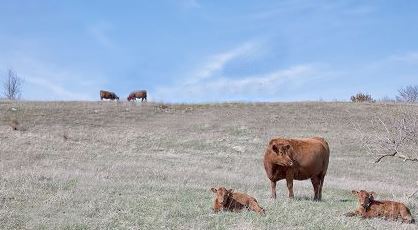



How to Prepare for Grass Tetany, Grass Staggers
As spring comes, Dakota's cattlemen are advised to watch for grass tetany and be proactive about blood magnesium.This is according to Adele Hartley at South Dakota State University who writes that grass tetany, or grass staggers, is not normally evidenced until May.

In this article, the Cow/Calf expert explores steps to take to prevent grass tetany.
Even though it may seem premature, writes Mrs Hartley, it is never too early to plan and ensure proper management practices are in place.
Causes
For a better understanding of grass tetany and to be able to manage its risk, one needs to understand what factors play a role in it. These include:
- Low magnesium (Mg) content of rapidly growing grasses and pastures
- High potassium (K) content of rapidly growing grasses and pastures
- High crude protein content of grasses and pastures
- Bad weather, storms, stress, etc., that cause cattle to be “off feed” for 24-48 hours
- Lactation: losses of Mg and calcium (Ca) in milk
- Various combinations of the above factors resulting in low blood Mg or Ca
Protection & Prevention
The key to prevention is to be proactive. Measures should be taken to minimize risks associated with cows grazing lush pastures. One long-term approach is to incorporate more legumes into pasture mixes. Legumes have higher levels of Mg and Ca than do immature grasses resulting in a better balance across the pasture. If possible, delay turn-out into lush pastures until plants are 4 to 6 inches tall. This will reduce the occurrence of tetany, in addition to giving drought-stressed pastures a little more time to rest. The reality is that many producers need to utilize pastures when grasses begin to green-up and the risk of tetany is most prevalent.

If delayed grazing is not an option, other management tools should be utilized. First, always provide a high magnesium (Mg) mineral supplement or mineral mix containing at least 8-12 per cent Mg.
This needs to be provided two to three weeks before turn-out or before tetany is likely to occur. Palatability and adequate intake can be challenging, resulting in some of the animals consuming on a daily basis inadequate amounts of the mineral.
Make sure all animals have access to the mineral supplement prior to and while grazing tetany-prone pastures, as this will help decrease the occurrence. Another potential tool is to provide hay while cattle are on lush pastures; however, cattle are not likely to eat hay unless forced to. Dry forages can act as carriers to provide the animals additional Mg and Ca at critical times.
If the drinking water source can be controlled (i.e., water tanks), soluble Mg salts may be added to the water. Some examples of soluble Mg salts are magnesium acetate, magnesium chloride, and magnesium sulfate (Epsom salts). The most common form of Mg, magnesium oxide, is not soluble in water and therefore cannot be used for this purpose.
Symptoms & Treatment
Older, lactating cows with calves younger than 2 months of age have the greatest susceptibility to tetany; while steers, heifers, dry cows, or cows with calves older than 4 months of age are less susceptible. Mature cows are more susceptible because they are less able to mobilize Mg from bones to maintain the necessary level in their system. Also, cows within two months after calving have increased milk production and require additional Ca and Mg.
Cattle will exhibit symptoms of grass tetany, but they may not be observed as death may occur relatively rapidly within 4 to 8 hours. An affected animal will exhibit a series of progressive signs. These include grazing away from the herd, irritability, muscle twitching in the flank, wide-eyed and staring, muscular incoordination, staggering, collapse, thrashing, head thrown back, coma, and finally death. Affected animals should be handled calmly, since sudden death can occur if animals are stressed.
There are treatment options for animals, but its effectiveness depends on the clinical stage when administered. If treatment is started one or two hours after clinical signs develop, the results are usually a quick recovery. Treatment is not effective if delayed until the coma stage. Grass tetany can be treated with an intravenous dextrose-based commercial preparation of magnesium and calcium purchased from a local veterinarian.
Remember cattle are more susceptible to grass tetany in the spring, and certain weather conditions increase susceptibility. Consider and implement prevention practices, monitor cattle for signs of grass tetany, and treat as soon as possible according to a protocol developed with a veterinarian.


